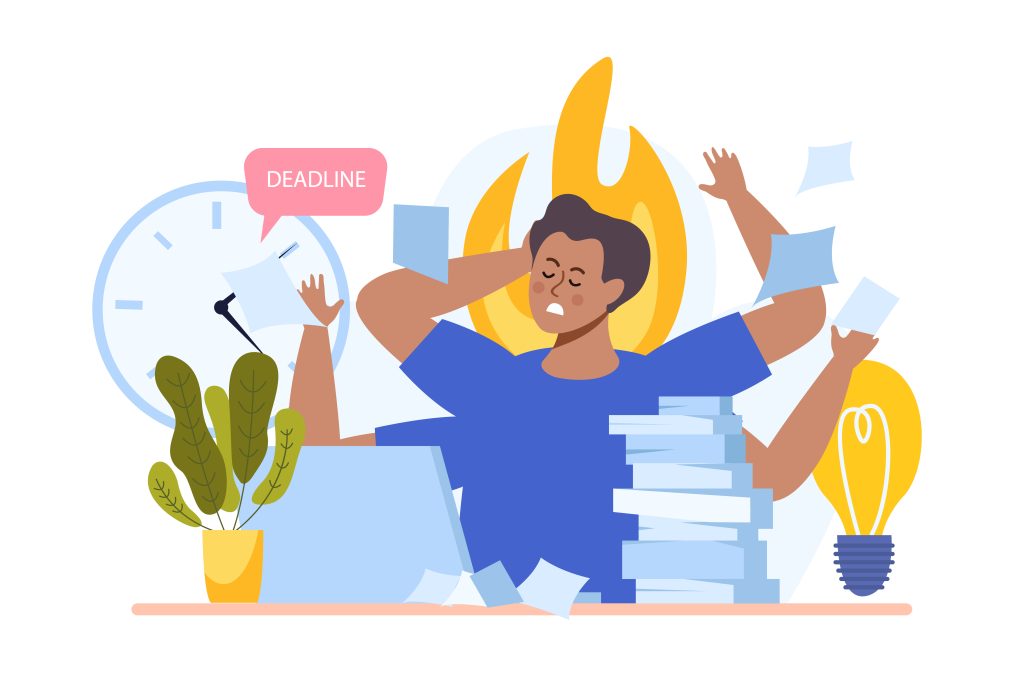In today’s hyper-productive world, we’re sold the belief that “doing more” is the ultimate key to success. But emerging research and expert opinions now reveal a shocking truth: doing more often delays results. From entrepreneurs burning out to employees chasing productivity myths, the overwork trap is not just inefficient—it’s downright counterproductive.

1. The Hustle Fallacy: Why More Isn’t Better
We live in an era where busyness is mistaken for productivity. But a study published in the Harvard Business Review found that high performers actually worked fewer hours and took more breaks compared to their peers, yet delivered better results (Davis and Peiperl, 2022). Why? Because they focused on what truly mattered.
The Myth of Multitasking
Research from Stanford University shows that multitasking reduces productivity by as much as 40% (Ophir, Nass and Wagner, 2009). Our brains aren’t wired to juggle multiple tasks simultaneously—each switch drains cognitive energy and lowers performance quality.
2. When “More Effort” Means Diminishing Returns
Spending more hours doesn’t necessarily yield better outcomes. In fact, the law of diminishing returns kicks in quickly. Once you exceed a certain workload threshold, the additional effort leads to exhaustion and decision fatigue.
Burnout is a Bottleneck
The World Health Organization classifies burnout as an occupational phenomenon. Chronic workplace stress, especially caused by overloading tasks, often results in decreased efficiency, poor decision-making, and lower morale (WHO, 2019). This ironically delays progress instead of accelerating it.
3. Parkinson’s Law: Work Expands to Fill Time
Coined by Cyril Northcote Parkinson in 1955, this principle states that “work expands so as to fill the time available for its completion.” Overloading your schedule only inflates the time tasks take, reducing effectiveness.
Timeboxing Beats Task Bloating
Modern productivity experts advocate for timeboxing—allocating fixed time blocks to tasks. This not only sharpens focus but also creates a psychological constraint, which leads to faster completion and better results.
4. Simplicity is the New Superpower
Startups and tech giants alike are learning that minimalism beats complexity. Apple, for instance, focuses intensely on fewer products but delivers market-defining innovation. By doing less—and doing it better—they outperform competitors who diversify excessively.
Strategic Subtraction
Greg McKeown’s bestselling book Essentialism argues that successful people and companies prioritize only what’s essential and eliminate the rest (McKeown, 2014). Less effort on non-essentials leads to faster and better outcomes.
5. The ROI of Focus
Being busy is not the same as being productive. High-impact professionals focus on Return on Investment (ROI)—measuring whether a task actually contributes to the end goal.
The 80/20 Rule
Also known as the Pareto Principle, this rule shows that 80% of outcomes come from just 20% of inputs. Instead of “doing more,” effective professionals identify the critical few actions that yield the greatest results.
6. Real-World Examples: When Less Did More
- Basecamp, a software company, famously caps workweeks at 40 hours and bans overtime. Despite this, they remain highly profitable and have a loyal customer base.
- Toyota applied lean methodology to reduce waste—not add workload—and revolutionized manufacturing.
- Cal Newport, professor and author, writes just a few hours a day yet publishes widely read books and articles. His “deep work” philosophy rejects the more-is-better myth.
7. Actionable Takeaways: Do Less to Achieve More
- Set 1–3 daily priorities: Focus on fewer but high-impact tasks.
- Use timeboxing: Limit how long you’ll spend on each task.
- Apply the 80/20 rule: Identify tasks that yield disproportionate value.
- Schedule breaks: Science shows that rest increases output.
- Say no: Protect your focus by refusing non-essential tasks.
Conclusion: Redefining Productivity
Doing more is not the secret to achieving results—it’s often the very thing that delays them. Real productivity comes from working smarter, not harder. Focus, clarity, and rest aren’t luxuries; they are strategic tools. So, before you add one more task to your to-do list, ask yourself: Will this bring me closer to my goal—or just keep me busy?
References
- Davis, A. and Peiperl, M. (2022) ‘Why high performers take more breaks and work fewer hours’, Harvard Business Review. Available at: https://hbr.org (Accessed: 25 June 2025).
- Ophir, E., Nass, C. and Wagner, A.D. (2009) ‘Cognitive control in media multitaskers’, Proceedings of the National Academy of Sciences, 106(37), pp. 15583–15587. Available at: https://www.pnas.org (Accessed: 25 June 2025).
- World Health Organization (2019) ‘Burn-out an “occupational phenomenon”: International Classification of Diseases’, WHO Newsroom. Available at: https://www.who.int (Accessed: 25 June 2025).






